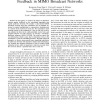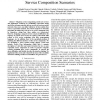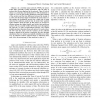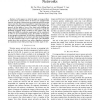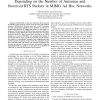ICC
2007
IEEE
14 years 6 months ago
2007
IEEE
Abstract— In this paper, we have investigated the maximumlikelihood (ML) receivers for the fast frequency-hopped binary frequency-shift-keying (FFH/BFSK) spread-spectrum communic...
ICC
2007
IEEE
14 years 6 months ago
2007
IEEE
—In this paper, we analyze the impact of imperfect channel quality feedback on the scheduling algorithms that exploit multi-user diversity. We consider a time-slotted MIMO broadc...
ICC
2007
IEEE
14 years 6 months ago
2007
IEEE
Abstract— In this paper we analyze the performance of multiple relay channels when multiple antennas are deployed only at relays. Specifically, we investigate the simple repetit...
ICC
2007
IEEE
14 years 6 months ago
2007
IEEE
— We present algorithms to suppress the asynchronous co-channel interference (CCI) in MIMO OFDM systems, which is becoming the dominant limiting factor in the performance of the ...
ICC
2007
IEEE
14 years 6 months ago
2007
IEEE
— Mobile ad hoc networking allows nodes to form temporary networks and communicate with each other possibly via multiple hops. By using a special node called the gateway, an ad h...
ICC
2007
IEEE
14 years 6 months ago
2007
IEEE
—Ubiquitous service composition provides new services and applications seamlessly by establishing cooperation among any devices in home networks and any services in service provi...
ICC
2007
IEEE
14 years 6 months ago
2007
IEEE
— In a wireless sensor network (WSN), the sensor nodes (SNs) generally localize themselves with the help of anchors that are pre-deployed in the network. Time of Arrival (ToA) is...
ICC
2007
IEEE
14 years 6 months ago
2007
IEEE
— In this paper, we study the angle coverage problem in visual sensor networks where all sensors are equipped with cameras. An object of interest moves around the network and the...
ICC
2007
IEEE
14 years 6 months ago
2007
IEEE
— In this paper, we propose a distributed power control algorithm for multihop ad hoc CDMA networks. The algorithm attempts to maximize the QoS of each user as well as a global n...
ICC
2007
IEEE
14 years 6 months ago
2007
IEEE
— MIMA-MAC is the most attractive MAC protocol for MIMO ad hoc networks, which consist of nodes with multiple antennas. MIMA-MAC, however, uses only a half of antennas for data t...

